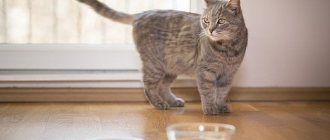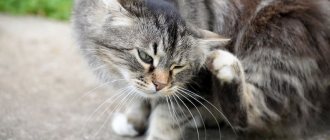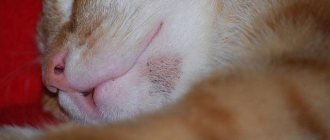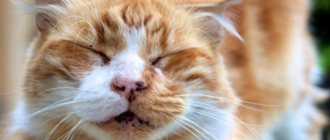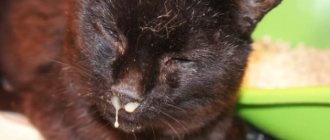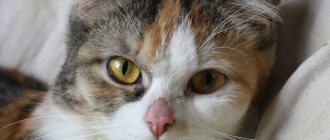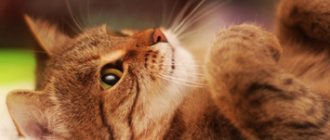Felines are arguably the cleanest pets and require minimal hygiene requirements from their guardian. However, certain breeds or certain situations may require your cat to wipe its nose. While many cats allow themselves to do this without issue, many others will resist.
So, cleaning a feline's nose can be challenging. As always, you should be very relaxed before working with a cat and every movement should be smooth so as not to upset the animal. Without further ado, here are some tips to help you clean your pet's nose.
Nose injuries
The crusts on your cat's nose may be brownish or black. This symptom is characteristic of a fungal infection, an inflammatory process in the nasopharynx, or an allergic reaction. The most harmless cause of crust formation is considered to be household injuries.
The fact is that a healthy cat's nose is slightly moist. This prevents the normal restoration of damaged skin, so wounds can take a long time to heal. If the owner is absolutely sure of the nature of the crusts, it is necessary to help the pet’s body recover as quickly as possible. To do this, it is recommended to treat your nose with an antiseptic several times a day. Preventing re-infection of the wound significantly accelerates regeneration and the crusts begin to disappear a few days after the start of treatment.
A dark crust on the nose, which is accompanied by discomfort and is a consequence of skin damage, should not be a cause for concern. In this case, no treatment is required; the crust will fall off on its own when the tissues are completely restored.
Treatment with an antiseptic is only necessary if weeping erosions or crusts appear at the site of the wound, blocking the respiratory tract.
Non-communicable causes
There are the following types of non-infectious diseases in which crusts form on the nose:
- allergic conditions;
- injuries;
- violation of conditions of detention.
Allergic conditions
All allergens that cause a runny nose lead to the release of exudate, which dries out and crusts form. The nasal mirror is injured by hard scabs, ichor is released, secondary microflora is added and the pet’s condition worsens.
The development of a hypersensitive reaction is influenced by the following unfavorable factors:
- increased sensitivity to feed mixture ingredients;
- response to pollen from flowering plants;
- irritating effects of perfume odors, tobacco smoke, household chemicals;
- irritating effects of toys, tray filler, bedding made of synthetic materials;
- reaction to human hair or the fur of other pets;
- side effects of medications.
Treatment consists of eliminating the causes. Caused an inappropriate reaction. They stop taking medications that can cause an allergic response and switch to ready-made hypoallergenic food.
Remove objects that emit odors from the room and stop smoking in the presence of the pet. Change the tray filler and bedding. In some situations, the use of antihistamines is required.
Injuries
Such crusts heal on their own
. Crusts are formed if a cat scratches its nose in a fight or through contact with sharp or prickly objects. When you hit the nose, slight bleeding may occur; the released liquid dries, forming crusts. If there is no suppuration under the scabs, observe the healing process of skin defects. Otherwise, use an antiseptic wound-healing ointment.
Be sure to read:
One of the cat's eyes is watering: reasons, what to do at home, medications and folk methods
Violation of containment conditions.
When the central heating is turned on in winter or during hot weather, the air dries out and the skin on the cat's nose cracks. The ichor is released, which dries and forms crusts. If in hot weather the cat is exposed to a stream of cold air from an air conditioner, hypothermia develops and rhinitis occurs, in which snot is released from the nose. They dry out and form crusts.
Frequent bathing in combination with drafts in the apartment also leads to hypothermia and rhinitis. Treatment consists of introducing immunomodulatory or antimicrobial drops into the nasal cavity.
Infectious diseases
If a cat has black crusts on his nose that do not heal for a long time, the cause should be sought in infectious diseases. Associated symptoms of infectious diseases:
- Nasal discharge.
- Conjunctivitis.
- Otitis.
- Frequent sneezing.
- Decreased appetite.
- Lethargy.
- Increased sleepiness.
In this case, the animal may refuse to eat and be lethargic. Particularly severe forms of infectious diseases are accompanied by vomiting, diarrhea, and dehydration.
Cat infections are very dangerous, especially if the animal does not have all the necessary vaccinations. Black crusts on the nose are one of the most harmless symptoms; in severe cases, infectious diseases can lead to the death of the pet. You cannot try to cure the cat yourself; you should take the animal to a veterinary clinic. This may require long-term hospital treatment.
We recommend the article: A cat has crusts on its ears - is it dangerous?
Sunlight has no effect on lentigo
It is known that in humans, freckles become more intense in color in the spring and summer. Lentigines are not exactly freckles (although they are similar in “behavior” and appearance) and they do not depend on sunlight.
However, direct sunlight must be treated with care. Lentigines may darken slightly due to tanning, and the skin around them may become damaged due to burns. Since the nature of lentigines is still not understood, many veterinarians assume that the bulging growths can develop into melanoma (skin cancer).
Important! It is lentigo that often causes the first symptoms of skin cancer – dark, raised spots – to be missed.
Dermatological diseases
Crusts on a cat’s nose can be the result of skin pathologies and dermatitis. These diseases are caused by fungi and bacteria. To accurately determine the cause of the formation of crusts, it is necessary to undergo a series of tests, including a nasal microflora smear and skin scraping from the affected area. The doctor will also illuminate the animal with a special lamp, which allows you to quickly determine the presence of fungal infections.
Treatment depends on the type of disease. For fungal infections of the epidermis, antimycotic drugs are used. Treatment is carried out using ointments and solutions for treating the nose. In case of a bacterial infection, the crusts should be treated with antibacterial drugs, for example, Levomekol ointment.
For dermatological diseases, antiseptic treatment of the affected area is mandatory. This is necessary to prevent secondary infection. For this purpose, a solution of chlorhexidine or miramistin is used.
Primary atrophic rhinosinusitis
Primary atrophic rhinosinusitis is more often diagnosed in patients from low socioeconomic status groups living in geographic areas with warm climates. Areas of high prevalence include southern Saudi Arabia, China, Africa, India, the Mediterranean and the Philippines.
Atrophic rhinosinusitis is more common in women. It is diagnosed more often at young ages than at older ages.
Clinical picture
Patients experience a constant sensation of an unpleasant odor in the nose (this disorder of smell is called cacosmia). At the same time, there is also an unpleasant odor from the mouth, noticeable to others. This is where the term “ozena” (“stench”) comes from, which is sometimes used as a synonym for severe primary atrophic rhinosinusitis.
Other symptoms include lack of sense of smell (anosmia), nosebleeds, nasal pain, sleep disturbances, and suffocation due to excessive crusting.
Patients complain of nasal congestion even with excessively wide nasal passages, which is better characterized by the concept of “lack of sensation of breathing.” Nasal congestion occurs due to improper passage of air through the nasal cavity, lack of resistance and sensation of air flow due to loss of tissue containing sensory receptors. The same phenomenon is observed in patients with perforation of the nasal septum.
The disease is characterized by the replacement of normal pseudostratified columnar epithelium with squamous epithelium. This tissue lacks cilia and mucus-producing goblet cells.
The most common culprits of the bacterial process in the nose are Klebsiella ozaenae, Proteus, Escherichia coli, Staphylococcus aureus, Streptococcus pneumoniae.
ENT examination
During rhinoscopy (examination of the nose), the doctor sees a shiny, thin, pale, and sometimes ulcerated mucous membrane, covered with thick yellow, brown or green crusts, sometimes bloody, covered with a purulent coating. Resorption (destruction) of the underlying cartilage and bone leads to an increase in the volume of the nasal cavity. Some patients are diagnosed with perforation of the nasal septum and secondary saddle deformation of the external nose (recession of the nasal dorsum).
Predisposing factors to the development of primary atrophic rhinosinusitis are completely unknown. It is discussed that these could be endocrine, vascular, infectious and autoimmune diseases, as well as occupational hazards (working in dusty, contaminated areas with chemical or industrial dust).
Computed tomography of the nose and paranasal sinuses
Possible finds include:
- atrophy of the mucous membrane of the lower and middle turbinates and bone resorption;
- resorption of cells of the ethmoidal and uncinate labyrinth;
- an increase in the volume of the nasal cavity with destruction of its lateral walls;
- thickening of the mucous membrane of the paranasal sinuses;
- hypoplasia (reduction) of the maxillary sinuses with a decrease in their pneumatization (airiness).
Scabs on a cat's nose photo
Wounds and allergies
Sores and crusts on a cat's nose and around the lips may be the result of an allergic reaction. Typically, such symptoms appear in response to food allergens, but damage to the skin of the nose can be caused by contact with household chemicals.
For treatment, special antihistamine drops are used. You can buy them at a veterinary pharmacy. If the allergic reaction is moderate, it is enough to eliminate the irritant for the symptoms to subside. No specific treatment is required; it is enough to avoid contact with the allergen in the future and treat the crusts with an antiseptic to prevent infection.
Diagnosis and treatment
If a cat has a white or bluish nose, then there is a suspicion of anemia or cardiac pathology. A red nose may indicate injury. To identify the cause, the veterinarian listens to complaints, conducts an external examination and prescribes diagnostic procedures, depending on the preliminary diagnosis, such as:
- radiography;
- ECG;
- blood chemistry;
- scraping scales from the skin to test for fungus;
- analysis of ear discharge to detect ticks;
- polymerase chain reaction to detect herpes virus.
Cat noses are treated depending on the disease. Rhinotracheitis is incurable, but an acute attack can be treated with antibiotics or antiviral drugs, which are individually prescribed by a veterinarian. For injuries, rhinoplasty is performed or anti-inflammatory drugs are used. Special drops are prescribed against fungus or ear mites. With necrosis, dead particles are eliminated.

